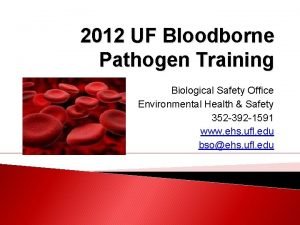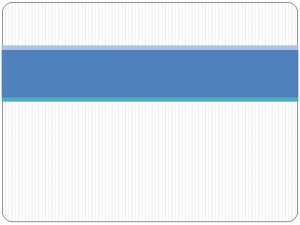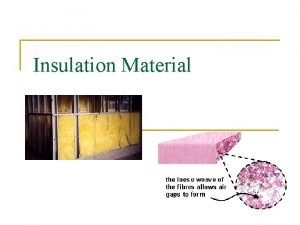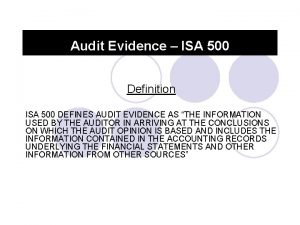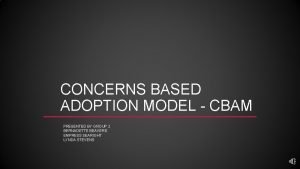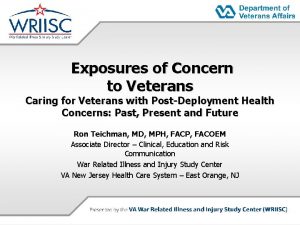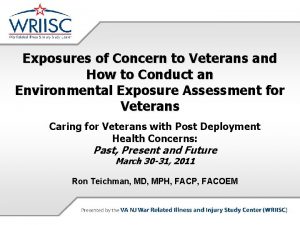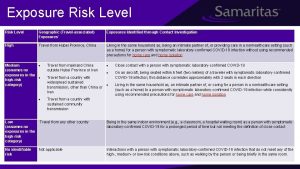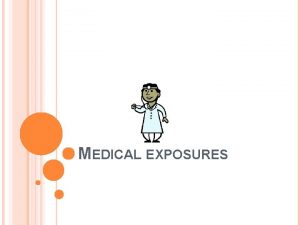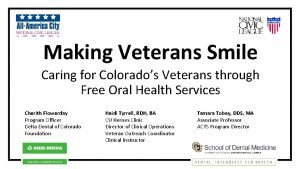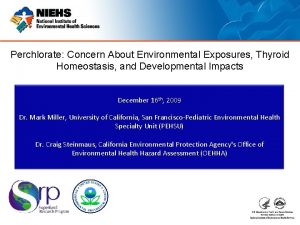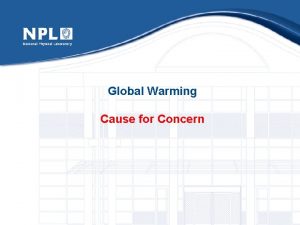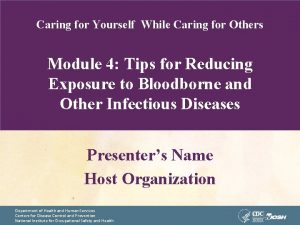Exposures of Concern to Veterans Caring for Veterans




















- Slides: 20

Exposures of Concern to Veterans Caring for Veterans with Post-Deployment Health Concerns: Past, Present and Future Ron Teichman, MD, MPH, FACP, FACOEM Associate Director – Clinical, Education and Risk Communication War Related Illness and Injury Study Center VA New Jersey Health Care System – East Orange, NJ

Perspective § Total number of US service members deployed to OEF/OIF = 1, 700, 000 § Total number of US service members separated, i. e. , Veterans = 1, 016, 213 § Received some health care from VA = 454, 121; ~ 45% of returnees § 95% outpatient, 5% inpatient

Perspective – cont’d. § VHA sees approximately 5, 500, 000 Veterans per year § 454, 121 OEF/OIF Veterans seen over 7. 5 years § Total number of OEF/OIF Veterans seen over 7. 5 years = approximately 8% of all Veterans seen in a single year

Seamless Transition § The transfer of personnel from the Department of Defense to the Department of Veterans Affairs § Do. D DVA § Service Member to Veteran § Post-Deployment Health Assessment upon return (PDHA) § Post-Deployment Health Re-Assessment in 3 -6 months (PDHRA)

Percentage of OEF/OIF service members who endorsed Exposure Concerns on PDHA and PDHRA (9/07 -10/08) § Active component § Pre-Deployment n=245, 378 0. 0% § Post-Deployment n=224, 511 16. 2% § Reassessment n=189, 933 21. 2% § Reserve component § Pre-Deployment n=85, 843 0. 0% § Post-Deployment n=75, 174 24. 9% § Reassessment n=96, 886 34. 8% § Frequency of exposure concerns rise after 3 -6 months MSMR Vol. 15 / No. 7 – Sept. 2008

Proportion of service members who endorse exposure concerns on post-deployment health assessments (1/04 -8/08) MSMR Vol. 15 / No. 7 – Sept. 2008

Top five Concerns of Veterans from Afghanistan and Iraq 1. 2. 3. 4. 5. Sand Noise Smoke from trash Vehicle exhaust JP 8 or other fuel MSMR Vol. 12 / No. 8 – Nov. 2006

MSMR Vol. 12 / No. 8 – Nov. 2006 Reserve 25. 0 Active Solvents 30. 0 Blast/ /Vehicleaccident Blast DEET on on skin Pesticidetreateduniform Pesticide Industrial pollution Excessive vibration Smoke from oil fire JP 8 or or Fuel Vehicle exhaust Smoke from trash Noise Sand Percent Frequency of OEF/OIF service member exposure concern reported on the PDHRA (9/05 -8/06) 20. 0 15. 0 10. 0 5. 0 0. 0

Top ten environmental exposures of concern: OEF/OIF 1. Smoke from burning trash or feces (44. 6%) 2. Sand dust storms (41. 5%) 3. Gasoline, Jet Fuel, Diesel Fuel (21. 1%) 4. Depleted Uranium (19. 0%) 5. Paint, solvents, other petrochems (15. 2%) 6. Oil well fire smoke (14. 9%) 7. Contaminated food and water (14. 4%) 8. Anthrax Vaccine (14. 2%) 9. Multiple Vaccinations (13. 9%) [8+9>3] 10. Vehicular Exhaust (10. 3%) Seen at NJ WRIISC, n=612. 1889 concerns, range 0 -15

Top ten environmental exposures of concern: Gulf War 1. Protective gear/alarms (82. 5%) 2. Diesel, kerosene, other petrochems (80. 6%)-3 3. Oil well fire smoke (66. 9%)-6 4. Local food (64. 5%)-7 5. Insect bites (63. 7%) 6. Harsh weather (62. 5%)-2 7. Smoke from burning trash or feces (61. 4%)-1 8. Within 1 mile of missile warfare (59. 9%) 9. Repellants and pesticides (47. 5%) 10. Paint, solvents (36. 5%)-5 From Schneiderman, Lincoln, Wargo, et. al. , APHA, 12 -14 -05

Prevalence (%) of exposures common to Vietnam, Persian Gulf and Bosnia-Kosovo

Case 1 Specialist Henry Davidson is a 30 year old OIF Veteran. He was born and raised in Rye, NY. After graduating high school in 1997, he attended a community college for two years then joined the US Army. His first overseas deployment was to OIF from 1/03 to 1/04. He worked as a truck driver delivering supplies throughout Iraq. He was based at the Balad Air Base and drove as far north as Mosul and as far south as Al Basra.

Case 1 - II He is concerned about the reports about the troops at the water treatment facility near Basra because in the spring of 2003 that was often a destination for his convoys and he sometimes spent time in the area playing football and Frisbee. He recalls a trip north in late June seeing and driving through a thick cloud with a foul odor of rotten eggs. His convoy was held up for half a day at a junction near where the smoke seemed to be coming from. In Iraq for the entire year he was frequently caught in sandstorms and suffered from intense heat. He describes the stench from the burn pit at his base as absolutely disgusting and literally nauseating. He had multiple near misses with IEDs.

Case 1 - III He returned to Iraq from 6/07 to 12/07. He was assigned to a motor pool at a base near Fallujah. On his local convoys he again had several near misses with IEDs. He reports that sometimes they went off with a dull thud, rather than a bang, and he recalls seeing a small plume of smoke whenever that happened. The base incinerated its waste, although he still was caught in sandstorms. The only other exposure that he is concerned about is the multiple vaccinations that he received, including three Anthrax shots. Since the end of his second deployment he complains of some diffuse muscle aches and mild, but progressive shortness of breath with exertion.

Case 1 - Issues § § § § Truck driver Ballad Air Base – burn pits Water treatment facility near Basra Cloud with rotten egg odor IEDs – explosions and no explosions Sandstorms Multiple vaccinations, including Anthrax § Muscle aches § Shortness of breath

Case 2 - I Sam Smith is a 54 year old former US Marine. He served in the Marines from 1974 until 1986 then in the Marine Reserves from 1986 until 1994. His one combat deployment was to the Gulf War from 12/90 until 4/91 with his reserve unit. He initially spent one month in Saudi Arabia and then when the ground war began he led his unit of tanks across a mine field during which he came under fire by shells that landed nearby but didn’t explode.

Case 2 - II He heard multiple chemical alarms and wore his MOPP IV gear for extended periods of time. Others in his unit received letters from the Do. D about some ammo dump at Khamasiyah, but he didn’t. He saw the oil well fires, his tanks were covered with soot as was the sand that his tanks kicked up. He frequently salvaged equipment and parts from damaged tanks. He handled a lot of dead bodies initially and after the ground war his unit was tasked with guarding large numbers of prisoners. While in the tank his intermittent low grade low back pain became significantly worse and persistent and continues to the present.

Case 2 - III Since being in Saudi Arabia he has been dealing with intermittent diarrhea and constipation, which also persist to the present. In 1995 he developed a rash over his chest and arms, which is worse in summer months, better in cool weather, itches, and has resisted treatment with a variety of over-the-counter creams. Since returning from the Gulf he has felt that he has had memory problems, forgetting people’s names, even people that he worked with on a daily basis. He also had trouble remembering simple lists and numbers, like the combination to his locker at work. Memory problems weren’t an issue for him before the deployment.

Case 2 - Issues § § § One month in Saudi Arabia Shells that did and didn’t explode Chemical alarms, MOPP gear, Khamasiyah Oil well fires and plume Damaged tanks Dead bodies and prisoners § § Low back pain Diarrhea and constipation Rash Memory problems

Thank you
 Caring occasion/caring moment
Caring occasion/caring moment How many splash exposures were reported at uf in 2020?
How many splash exposures were reported at uf in 2020? Uf bloodborne pathogen training
Uf bloodborne pathogen training Foreign exchange exposures
Foreign exchange exposures Did investigator assign exposures
Did investigator assign exposures How many splash exposures were reported at uf in 2020
How many splash exposures were reported at uf in 2020 Content analysis secondary data
Content analysis secondary data Water pollution and unequal distribution illustration
Water pollution and unequal distribution illustration Accountin principles
Accountin principles Iowa concern hotline
Iowa concern hotline Going concern princip
Going concern princip Going concern concept
Going concern concept Prime concern
Prime concern Age concern gosport
Age concern gosport The owners of a small manufacturing concern have hired
The owners of a small manufacturing concern have hired Why is water pollution of great concern in southwest asia
Why is water pollution of great concern in southwest asia Isa 500
Isa 500 Concerns-based adoption model
Concerns-based adoption model Going concern princip
Going concern princip 7 accounting principles
7 accounting principles Belgospischeprom
Belgospischeprom





